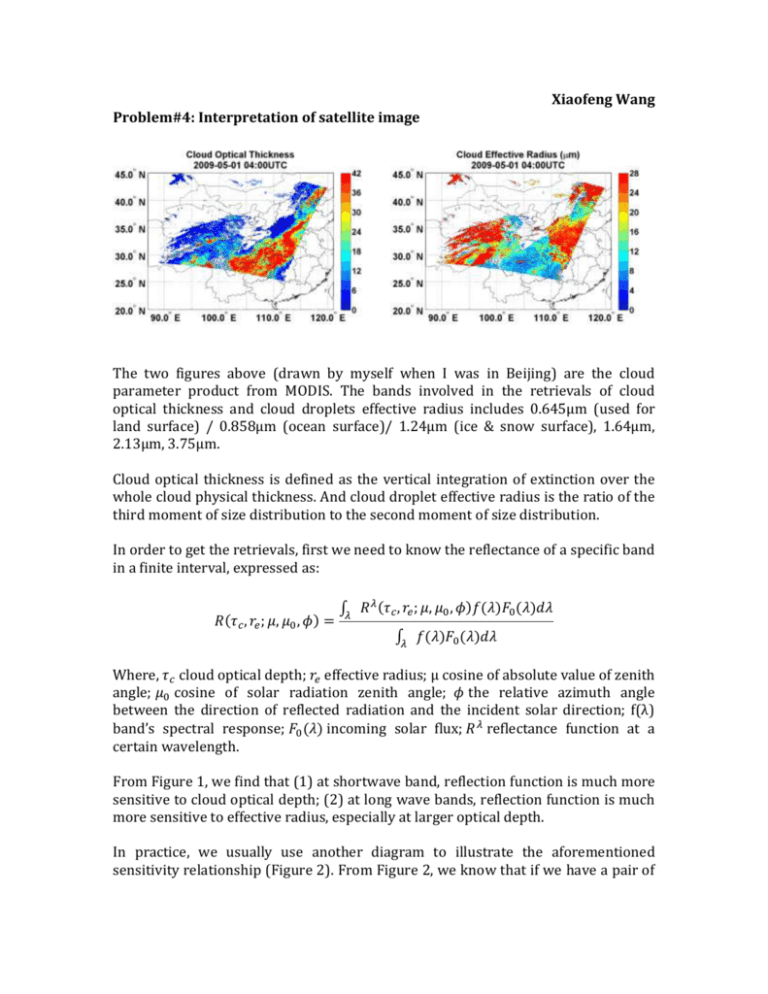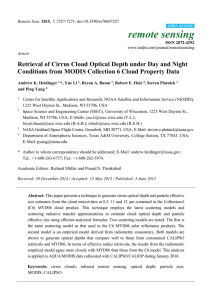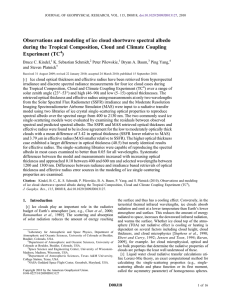Xiaofeng Wang
advertisement

Problem#4: Interpretation of satellite image Xiaofeng Wang The two figures above (drawn by myself when I was in Beijing) are the cloud parameter product from MODIS. The bands involved in the retrievals of cloud optical thickness and cloud droplets effective radius includes 0.645µm (used for land surface) / 0.858µm (ocean surface)/ 1.24µm (ice & snow surface), 1.64µm, 2.13µm, 3.75µm. Cloud optical thickness is defined as the vertical integration of extinction over the whole cloud physical thickness. And cloud droplet effective radius is the ratio of the third moment of size distribution to the second moment of size distribution. In order to get the retrievals, first we need to know the reflectance of a specific band in a finite interval, expressed as: 𝑅(𝜏𝑐 , 𝑟𝑒 ; 𝜇, 𝜇0 , 𝜙) = ∫𝜆 𝑅 𝜆 (𝜏𝑐 , 𝑟𝑒 ; 𝜇, 𝜇0 , 𝜙)𝑓(𝜆)𝐹0 (𝜆)𝑑𝜆 ∫𝜆 𝑓(𝜆)𝐹0 (𝜆)𝑑𝜆 Where, 𝜏𝑐 cloud optical depth; 𝑟𝑒 effective radius; µ cosine of absolute value of zenith angle; 𝜇0 cosine of solar radiation zenith angle; 𝜙 the relative azimuth angle between the direction of reflected radiation and the incident solar direction; f(λ) band’s spectral response; 𝐹0 (𝜆) incoming solar flux; 𝑅 𝜆 reflectance function at a certain wavelength. From Figure 1, we find that (1) at shortwave band, reflection function is much more sensitive to cloud optical depth; (2) at long wave bands, reflection function is much more sensitive to effective radius, especially at larger optical depth. In practice, we usually use another diagram to illustrate the aforementioned sensitivity relationship (Figure 2). From Figure 2, we know that if we have a pair of reflection value, we can get corresponding value of cloud optical thickness and effective radius through interpolation. With this knowledge and the reflection function, after calculating different reflection value under diverse angles, cloud optical thickness and effective radius, a look-up table for cloud parameter can be generated. So when we know the reflection function at a band in satellite, through some interpolation processes in the look-up table, we will get the cloud optical thickness and effective radius simultaneously. The 2.13 band retrievals of effective radius and optical thickness in combination with shortwave band are set as default in MODIS cloud products. Effective radii from the 1.64 and 3.75 band are usually reported as differences in effective radius relative to 2.13 band. (Figure 1: From King et al., 1997, Page 16) (Figure 2: From Liou 1997, Page 374) References: King, M. D., S. C. Tsay, S. E. Platnick, M. Wang, and K. N. Liou. Cloud retrieval algorithms for MODIS: optical thickness, effective particle radius, and thermodynamic phase, MODIS Algorithm Theoretical Basis Document No. ATBD-MOD-05, Dec. 23, 1997, Version 5 Liou, K. N.. An Introduction to Atmospheric Radiation, Academic Press, 2002, 2nd Edition Platnick, S., M. D. King, Member IEEE, S. A. Ackerman, W. P. Menzel, B. A. Baum, J. C. Riédi, and R. A. Frey. The MODIS Cloud Products: Algorithms and Examples From Terra, IEEE Transactions on Geoscience and Remote Sensing, 2003, 41(2), 459-473








